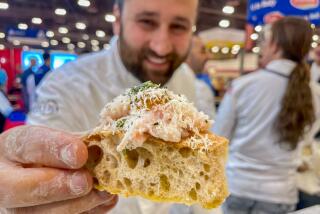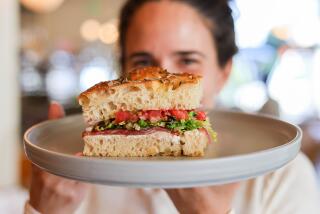CPK, Pitfire, Fresh Brothers offer gluten-free pizzas

Surely one of the saddest consequences of the gluten-free life is the limits on pizza -- absolutely tops on my list of foods to take to a deserted island. But there is hope.
California Pizza Kitchen introduced this month, for the second time, gluten-free pizzas, with all the care it takes to market them to people with celiac disease – people for whom just a small bit of wheat could prompt serious illness.
And two local chains, Pitfire Artisan Pizza and Fresh Brothers, have also responded to customers’ desires for gluten-free crusts.
All three make gluten-free pizzas that taste good. That said, don’t expect any of them to offer that wonderful experience of chomping on a chewy, full of holes edge of crust that some people adore while others leave on the plate. What you get is a perfectly fine delivery system for toppings, more toward crackerbread than pizza crust.
And for people watching their carb intake, “it’s not a free pass,” said Paul Hibler, a co-founder of Pitfire, with eight locations in the L.A. area. Many gluten-free products have carbohydrates – it’s just gluten they don’t have. Gluten is found in wheat, barley and rye.
“Pizza is a little like alchemy -- the sum of all the parts,” Hibler said.
California Pizza Kitchen worked with the Gluten Intolerance Group to have its gluten-free pizzas certified, “so diners would have a comfort level,” Bob Moncrief, vice president of training and development, said at a press preview of the pizzas at CPK’s test kitchen in Redondo Beach.
The company has a system in place for training kitchen and dining room staff in its 200 restaurants to make sure the pizza remains free of gluten when the customer eats it. (Gluten-free pizza is not available in airports and freezer cases.)
CPK, which introduced gluten-free pizzas once before, unsuccessfully, in 2010, was meticulous about the process and the taste this time, officials said. The company sets aside blue containers and lids, utensils and plastic gloves for use in making the gluten-free pizzas, which are topped in a separate area of the kitchen. Blue stickers are used on takeout boxes, too.
Its crust, which comes from an outside contractor, is based on rice flour, which makes the crust crisp, said Brian Sullivan, senior vice president of culinary development. It was, he said, hardest to reach a texture that was right.
CPK offers four gluten-free pizzas, including its most popular wheat version, the BBQ chicken pizza.
At Pitfire, the gluten-free crusts are not for anyone with serious medical issues, because of cross-contamination potential from the wheat flour in the kitchen.
“We sell so many of them, it’s almost frightening,” 40 or 50 in a shop a day, Hibler said.
The company tried to make its own gluten-free crusts, but “we failed miserably,” and contracted with a gluten-free bakery to provide the crusts, made from brown rice flour, potato starch and “all sorts of different things to kind of create something that will hold together without gluten,” Hibler said.
“There’s no jump, there’s no spring to it that there is with a real pizza crust,” Hibler said.
Fresh Brothers, with 11 L.A. area restaurants, has sold gluten-free pizzas for almost four years, said co-founder Debbie Goldberg. “We had a lot of friends whose kids had allergy issues, celiac, and they weren’t able to eat pizza. As a restaurant owner, you never want people not to be included.”
To avoid cross-contamination, the crusts come sealed from an outside company. The gluten-free pizzas are made in the cooler with separate tools, so no ambient flour attaches to them. Then to boxes that are sealed with tape “as a visual reminder for everyone that this is a gluten-free pizza,” she said.
Customers often ask a lot of questions about the gluten-free pies.
“I don’t get a sense of this at all that it’s the diet of the moment. I really believe this is not a trend, for people who realize that eating wheat is just not working for them,” she said.
“In four years things have really changed, and there are choices out there that taste good. But back then, it was cardboard after cardboard. We found a company we love and have used since then,” Goldberg said.
ALSO:
High-end bakeries turn out gluten-free treats
More to Read
Eat your way across L.A.
Get our weekly Tasting Notes newsletter for reviews, news and more.
You may occasionally receive promotional content from the Los Angeles Times.







